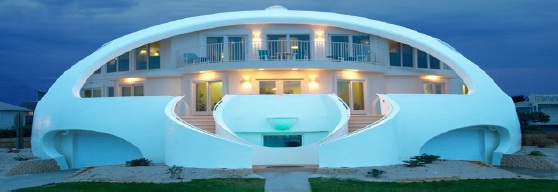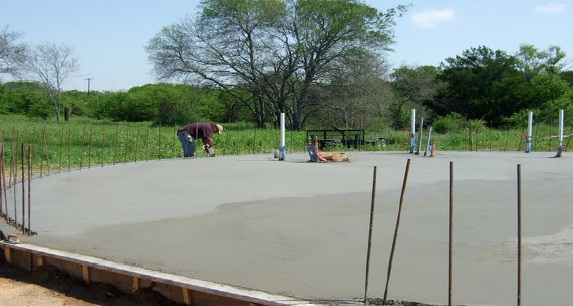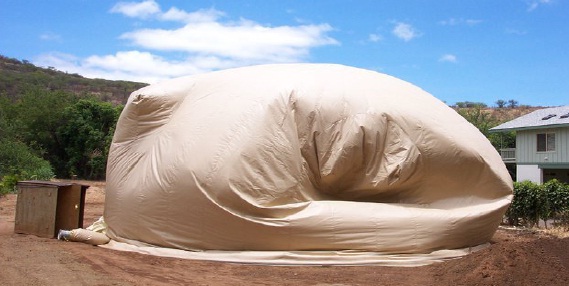Monolithic Dome
Published on Feb 14, 2016
Abstract
Dome is an element of architecture that resembles a hollow upper half of a sphere. Dome structures made of various materials have a long architectural lineage extending into prehistory. It may be defined as a thin shell generated by the revolution of a regular curve about one of its axis. The shape of the dome depends upon the type of the curve and the direction of the axis of revolution.
When the segment of a regular curve revolves about its vertical diameter, a spherical dome is obtained. Domes are used in variety of structures such as roof of circular areas, circular tanks, exhibition halls, auditorium, bottom of tanks and bunkers.
With the introduction of monolithic dome structures find wide applications in many branches of technology. From the point of view of architecture, the development of dome structure offers unexpected possibilities and opportunities for the combined realization of functional, economic and aesthetic aspects. Energy efficiency of building designs should be considered and is high in monolithic domes. A monolithic dome is a structure cast in a one-piece form. The form may be permanent or temporary and may or may not remain part of the finished structure. Monolithic is dedicated to improving people’s lives worldwide by introducing and constructing Monolithic Domes, for personal and public use, that are disaster-resistant, energy-efficient and cost-effective.
The energy saving features of domes are summarized by an architect who states, “Dome embody the virtues of simplicity, economy, and energy conservation, and enclose the maximum amount of space with the least surface area. It is this surface area which consists of building materials, and comprises the exterior skin of the building through which heat is gained, or lost. This is the essence of dome efficiency.”(Zimmerman,1992). For the construction of dome structures it requires airform kit. With the exception of airform kit, locally available materials are all that is needed to produce a dome.

Introduction
The monolithic dome, for a number of reasons, is very energy efficient. The spherical sections of the dome offer minimal surface area for the volume they contain, so there is less surface for heat transfer with the outside air. The construction of monolithic dome with proper earth sheltering will withstand bomb blasts more effectively than conventional structures. The strength and stability of domes make them virtually immune to climatic catastrophe, or earthquakes, as well as to fire, or corrosion hazards. Monolithic Domes are the most energy efficient and safest buildings that can be built and that can be designed for many uses. Many schools now conduct their classes in Monolithic Domes. Some are designated as tornado shelters.
Others have Monolithic Dome gymnasiums, auditoriums, multipurpose centers, libraries, cafeterias, etc. Three brothers- David, Barry, and Randy south- built and patented the first monolithic dome in 1975. It was 105 feet (32m) in diameter, and 35 feet (1m) high, and is still used today. Now there are monolithic domes throughout the United States and the world- built north of the Artic Circle in Murmansk, Russia, to the Equator in Indonesia. Churches, schools, storage buildings, homes, and recreational centers all use monolithic domes. Sizes range from very small 8 foot (2.5m) to very large 260 foot (80m) diameter domes.
Objectives
The objectives of the investigation were:
To study the design of the dome.
To study about monolithic concrete domes.
Discuss about the construction and thermal performance of the monolithic domes.
Discuss about the advantages and disadvantages of monolithic dome.
Stresses Acting on Domes
Generally, a spherical dome may be imagining consisting of a number of horizontal rings placed one over the other. The diameters of the successive rings increase in the downward direction and the equilibrium is maintained independently of the rings above it. The circle of each ring is called latitude while the circle drawn through two diametrically opposite points on a horizontal diameter and the crown is known as a meridian circle. The entire meridian circles coverage at the crown of the spherical dome. Two types of stresses acting on the domes are
Meridional thrust (T) along the direction of meridian
Hoop stress along latitudes
The Process for building dome enclosures has been refined and streamlined over the years. There are two principle types of dome enclosures: Monolithic Domes, larger insulated homes and buildings, and Ecoshells, smaller domes developed especially for hot weather climates, disaster relief and redevelopment of substandard housing. Ecoshells represent the best option for low cost safe housing in areas where earthquakes, fires, floods and hurricanes are a possibility. Although ecoshells are not insulated, their design maintains a cool, near constant temperature. Ecoshells are ideal for areas with high summer and moderate winter temperatures. They are constructed using concrete and rebar and can be built in a short amount of time. Limited specialized tools are needed and the skills to build these unique structures are learnt quickly. Each Ecoshell airform can be used as many as one hundred times.
Materials
Generally standard materials and methods of monolithic dome construction were used. Variations and options chosen are listed below.
Airform kits
The airform kit was obtained from Monolithic constructors, Italy, Texas. The kit consisted of a 40 ft. (12 meter) diameter form along with reinforcing steel (rebar) anchors. The form was ordered in the shape of a half sphere with no custom window, or door augmentations.
Polyurethane Foam
Sprayed on polyurethane foam insulation was of a type using a part process in which Diphenylmethane-4, 4’-diisocynate was mixed with blended polyol resin.
Reinforcing Steel
Steel in the foundation and slab was 5/8 inch (16mm) and ½ inch (13mm) grade 40 rebar. In the dome shell, ½ inch (13mm) and 3/8 inch (9.5mm) grade 60 rebar was used.
Concrete
In the foundation and slab a standard 5 sack (470 pound cement per cubic yard), (214 kg cement per 0.76 cubic meter) concrete foundation mix was used. Concrete used in the dome shell was a 9 sack per cubic yard (0.7647 cubic meter) mix. This was made up of 846 pounds (385 kg) Portland cement, 2182 pounds (992 kg) sand, 394 pounds (179 kg) 3/8 inch (1cm) maximum diameter gravel, 1.5 pounds (0.7 kg) plastic fibers and 4 ounces (118 ml) air entraining agent delivered at a 2” (5cm) slump ready for the addition of water to pumping consistency. For the final coat of concrete, the gravel was eliminated and sand substituted.
Construction Methods
Modern construction differs significantly from the original concrete-over-dirt method. The current methods were developed by three brothers from Idaho: Barry, Randy, and David South. The first dome built using this method was constructed in Shelley, Idaho:
A reinforced concrete foundation, or "ring beam", is constructed, defining the shape of the base of the structure.
The fabric form, or air form, is attached to the foundation and inflated with an air blower. The air form contains an airlock to allow workers to enter the form while it is inflated.

A layer of polyurethane foam is sprayed on the interior of the form. (Its purposes are to give rigidity to the air form, secure the rebar in place, provide support for spraying in the concrete mixture, and insulate the final structure.)
Rebar is attached to the outside layer of foam, using clips that are attached to the foam.
Several inches of concrete are sprayed over the rebar frame.

After the concrete has set, the blower is turned off.
The exposed surface of the air form may be left as is, or a surface treatment such as paint, tile, etc., may be applied. (Proper selection of air form material will ensure prevention from long-term degradation due to ultraviolet radiation.)
In instances where necessity requires economical construction for multiple small and basic dwellings, the dome can be built without insulation and the air form can be removed after completion and re-used to build additional domes.
Conclusion
Monolithic is dedicated to improving people’s lives worldwide by introducing and constructing Monolithic Domes, for personal and public use, that are disaster-resistant, energy-efficient and cost-effective. Monolithic Domes are the most energy efficient and safest buildings that can be built and that can be designed for many uses. Many schools now conduct their classes in Monolithic Domes. Some are designated as tornado shelters. Others have Monolithic Dome gymnasiums, auditoriums, multipurpose centers, libraries, cafeterias, etc. Because Monolithic technology meets criteria for a structure that can provide near-absolute disaster protection, And in most cases, they save money on first cost for the construction. The monolithic dome has sufficient durability and which offers exceptional resistance to earthquake, fire and extreme wind.
More Seminar Topics:
Reinforced Concrete Corroded Columns, Self Compacting Concrete, Significance Of Nanotechnology In Construction Engineering, Skybus Technology, Soil Cement, Sonication, Stone Mastic Asphalt, Stress Ribbon Bridge, Submerged Floating Tunnels, Tensegrity Structures And Their Application To Architecture, Top Down Cracking, Underwater Turbines, Aging Of Bitumen, Control Of Corrosion On Underwater Piles, Ground Improvement Techniques, Analysis of Durability Of High Performance Concrete Using Artificial Neural Networks, Bacterial Concrete, Block Shear Failure in Tension Members, Burj KhalifaRelated Seminar Topics
- Burj Khalifa
- Aldar Headquarters
- Concepts Of Shotcrete Technology
- Concrete Admixtures
- Demolition Of Building
- DIAGRID